LMLK Home
Biblical Accounts
NonBiblical Accounts
Theories
HBRN
MMST
SUKE
ZYF
Generic
x (cannot classify)
2-Top
2-Divided
2-Undivided
4-Cursory
4-Lapidarist
Jars
Personal Seals
Incisions
Paleography
Typologies
Corpus
Stratigraphy
Geography
Displays
Publications
Credits
Updates

|
When considering whether 2 or more broken handles may have once belonged to the same jar, David Ussishkin wrote these cautionary remarks in BASOR 223:
It must be borne in mind that it is impossible to prove the point. One can use shape, size, color, material, texture, etc., to demonstrate the similarity between different handles, thus indicating that none of these factors is an obstacle to attributing the handles to the same jar, but that is as far as we can go. It has to be remembered that theoretically even identical handles could have belonged to different storage jars.
In the same article, he proceeded to identify several handles from Lachish that were similar enough to have comprised a single jar, & he did the same for several handles from Tell Beit Mirsim.
Below is a descriptive list that elaborates on Ussishkin's criteria, & provides detailed illustrations to assist researchers in their efforts to match handles with jars. As stated on the Corpus page, the quantity of stamped handles has no conclusive relationship with the quantity of stamped jars (i.e., 4 handles stamped with one type of seal may represent a single jar, while 4 stamped handles from another seal may represent 4 jars), so it's worthwhile to at least narrow down the range of how many jars may have been located at a particular site. Unfortunately, most excavators & antiquities dealers have not paid attention to unstamped handles, so we may never know for certain how many jars were used at Judean sites.

Marks
- Incisions
- Grooves
- Wet-Smoothing Fingerprints
Plus ("+") Marks & Concentric Circles may have been incised on all 4 handles of a jar irrespective of the LMLK seals. Since no complete jar with either of these incision types has been restored, the probability factors are unknown (i.e., whether an incision on a single handle was considered sufficient). Of all the factors listed on this page, the most conclusive would have to be the internal grooves resulting from the potter's fingers while the jar was spinning (i.e., being thrown & formed on the wheel). Stationary potter fingerprints may also be useful but since one potter may have made many jars, it's not unlikely to find the same fingerprints on different jars. A more specific clue for handle matching is the potter's wet-smoothing style, which leaves elongated fingerprints running the length of the handle.
Example of grooves (Redondo Beach #17):
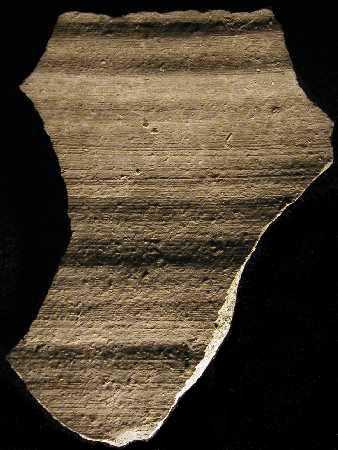
Example of wet-smoothing fingerprints (Redondo Beach #6):
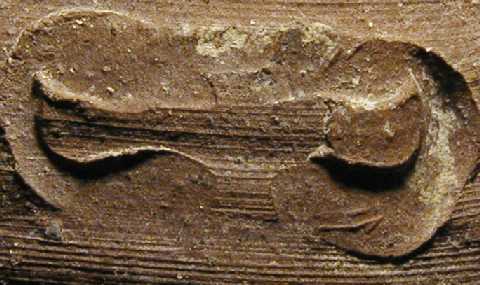

Provenance
- Excavation Site
- Antiquities Dealer
Naturally, if 4 handles with matching traits are recovered from the same location at the same site as part of a licensed, documented excavation, it's highly likely that they belong to the same jar. As the handles are recovered from various locations at a site or from different stratigraphic layers, it becomes less likely. Likewise, if several handles with similar characteristics become available at a reliable antiquities dealer who knows they came from the same source, they may be from the same jar, but the probability is decreased when considering handles from different dealers. The biggest detriment to provenance, however, is that many of these handles were used as fill (i.e., mixed piles of potsherds); so even if the 4 handles are excavated together, it's important to document what else was found with them.

Stamps
Assuming that the same person stamped multiple handles of the same jar at about the same time, the Quality, Orientation, & Location of the impressions should be similar since the clay of each handle would have been in the same state of plasticity. The person(s) who stamped the clay probably did so in a consistent manner assuming he/she didn't have to get into an awkward position (e.g., unless they had to reach across a table to stamp a handle on the opposite side of the jar instead of walking around the table or rotating the jar on the table or wheel). Exercise caution when excluding seals of different types since there's no reason to eliminate the possibility of more than one LMLK seal being used on the same jar (either by mistake or intentionally). Nor is it unreasonable to consider more than one type of Personal Seal being used on the same jar.
Example of stamp located on the outer handle curve (Redondo Beach #41):
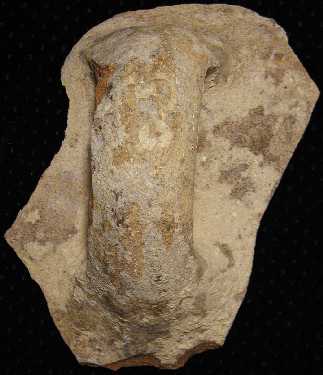
Example of stamp located near the handle joint (Redondo Beach #22):
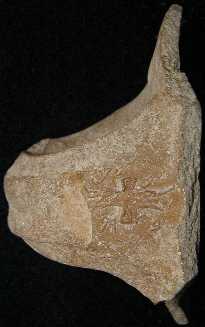

Shape
Consider the overall shape & construction of the handle. Some had large amounts of clay forming the joints; others did not. Some had 1 or 2 ridges with diverse elevations. And the overall length of the handle was either tapered (usually from wide at the top to narrow at the bottom--characteristic of pulled clay) or evenly formed (as if from a mold--characteristic of extruded clay). While the photos below make it easy to see the ridges & tapering, the bulkiness of the joints is subtler. The circumference of the clay at the joint can be measured by forming a small-diameter wire around it, then straightening the wire out along a ruler. LMLK joints vary from about 4" to 8". Both handles in the photos below have 6" top-joint circumferences.
Example of tapered handle with 2 ridges (Redondo Beach #9):
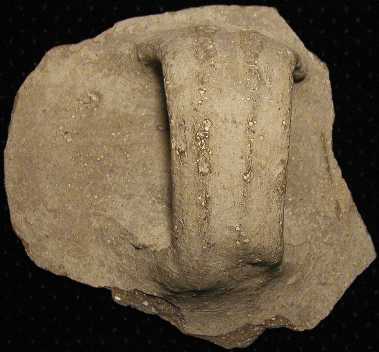
Example of non-tapered handle with no ridges (Redondo Beach #6):
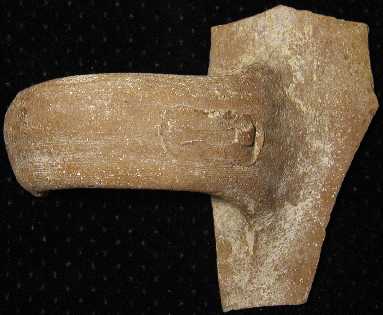

Size
- Width
- Thickness (handle & jar body)
- Loop Opening
Compare the measurements of the handle (depending on whether it is fragmented or complete). If tapered, make measurements of the circumference as close to the top & bottom joints as possible, & make a circumference measurement near the center of the loop. In addition to circumference measurements, if the handle is fragmented, measure the width & breadth (if it was not broken diagonally). Also measure the width of the jar body. If the handle is complete, measure the inside dimensions of the loop. The examples below are scaled equally relative to each other, but the one with larger cross-section dimensions was broken higher up in the loop, so tapering is a factor to consider when comparing these measurements.
Handle with large (1 5/8" x 7/8") cross-section (Redondo Beach #3):
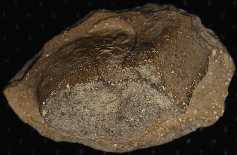
Handle with small (1 1/8" x 4/8") cross-section (Redondo Beach #10):
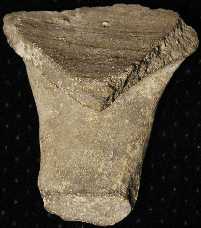
Handle on the left has a large loop (1 3/8" horizontal x 2 1/8" vertical; Redondo Beach #36);
handle on the right has a small loop (1" horizontal x 1 7/8" vertical; Redondo Beach #41) although the camera perspective distorts them a little bit:
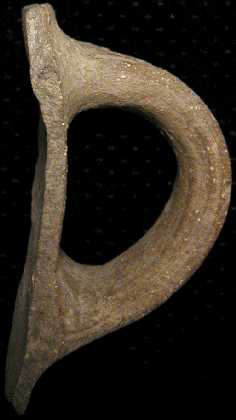
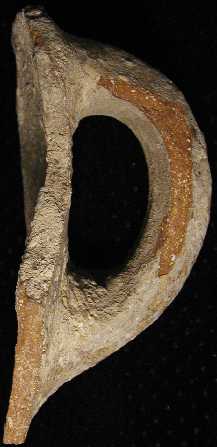
Also notice the significant difference in jar body thickness in these 2 handles. The one on the left fluctuates from about 3/16" to 5/16" while the one on the right varies from about 5/16" to 7/16".

Ware
- External Surface & Internal Surface
- Core & Grits
- Craters & Patina
Refer to the Composition section of the Jars page for details about the different ware types. Refer to the Stamp Interpretation Tricks page for descriptions of Craters & Patina. The ware characteristics should be similar on handles from the same jar, but not necessarily identical due to air flow fluctuations within the kiln as well as damage/weathering through the centuries (especially if the handles were stratified in different territories after the jar was broken).

Unprovenanced Examples

"So the man of God entreated the LORD, & the king's hand was restored to him, & became as it was before."--1Kings 13:6
|












